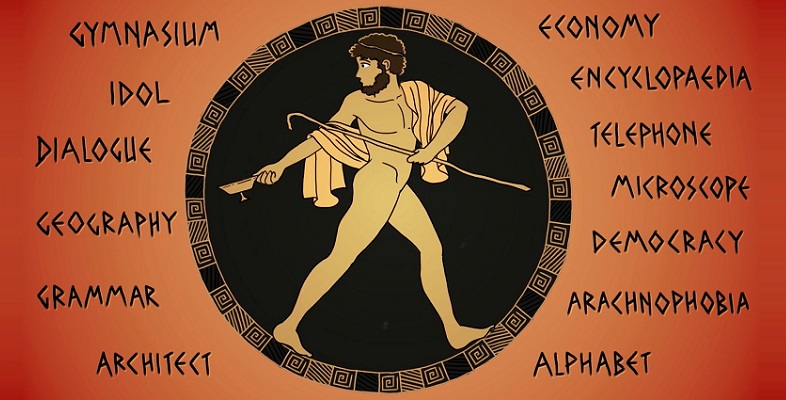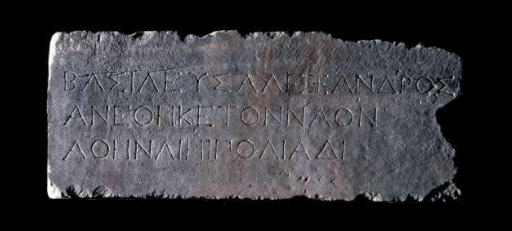1 Alexander’s dedication
Let us conclude the study of Alexander’s dedication by examining the third line:
βασιλεὺς Ἀλέξανδρος King Alexander
ἀνέθηκε τὸν ναὸν dedicated the temple
Ἀθηναίῃ Πολιάδι
Understanding the phrase Ἀθηναίῃ Πολιάδι requires an understanding of the dative case. An example of a dative from the New Testament was presented in Session 6 in the discussion of word order:
ταῦτα [these things] γράφω [write I] ὑμῖν [unto you]
The personal pronoun ὑμῖν is in the dative case. It is the equivalent of ‘unto you’, or, in contemporary English, ‘to you’. In the early stages of learning Greek you can think of the dative as the ‘to’ or ‘for’ case, although further study would reveal a wider range of uses.
Activity 1 Replace the verb
In the following sentence, can you think of English verbs that could replace ‘write’ without making the sentence ungrammatical? One example would be ‘donate’.
- I write these things to you.
Discussion
Potential substitutes for ‘write’ include ‘give’, ‘dedicate’, ‘say’, ‘speak’, ‘teach’, ‘offer’, ‘show’, ‘hand’.
Verbs of ‘giving’, ‘saying’ or ‘showing’ frequently imply a dative case because they describe an act involving a recipient, i.e. someone to whom a thing is given, said or shown. Indeed, the term ‘dative’ derives from the Latin word ‘to give’ (‘do’, which rhymes with ‘oh’). The noun in the dative case is called the indirect object. It answers the question, ‘To whom did she give/show/tell it’? The thing given, which so far has been referred to simply as ‘the object’ is, strictly speaking, the direct object.
Activity 2 Direct object case
a.
nominative
b.
accusative
c.
genitive
d.
dative
The correct answer is b.
Discussion
To refresh your memory of objects, refer to Session 6. Remember that ‘objects’ in Session 6 are properly described as direct objects to distinguish them from indirect objects.
The dative case endings for τιμή and λόγος are:
| τιμή, honour (1st declension) | ||
|---|---|---|
| singular | plural | |
| dative | τιμῇ | τιμαῖς |
| λόγος, word (2nd declension) | ||
| singular | plural | |
| dative | λόγῳ | λόγοις |
Activity 3 Recall the mark
Do you recall (from Session 1) the name of the mark underneath the final vowels of τιμῇ and λόγῳ?
Discussion
This mark is an iota subscript, ‘subscript’ being derived from the Latin for ‘written underneath’. You are most likely to encounter it in the dative singular of first and second declension nouns, and in a few verb endings not covered in this course. Iota subscript is a post-classical innovation from the Byzantine period. Originally the iota would have been written after the alpha, eta or omega. You can observe this on the third line of the inscription, which has Ἀθηναίηι for Ἀθηναίῃ.
Using the notes provided and your knowledge of the dative case, complete the translation of the dedication.
βασιλεὺς Ἀλέξανδρος King Alexander
ἀνέθηκε τὸν ναὸν dedicated the temple
Ἀθηναίῃ Πολιάδι
- Notes
- Ἀθηναίῃ Πολιάδι is the dative form of Ἀθηναία Πολιάς, the goddess ‘Athena Polias’ or ‘Athena Guardian of the City’. Ἀθηναία is an alternative form of Ἀθήνη.
Discussion
Here is the completed translation:
βασιλεὺς Ἀλέξανδρος King Alexander
ἀνέθηκε τὸν ναὸν dedicated the temple
Ἀθηναίῃ Πολιάδι to Athena Polias
Note that the dedication contains:
- a verb ἀνέθηκε (‘dedicated’) that prompts the expectation of both a direct and an indirect object
- three of the four cases introduced in this course (nominative, accusative and dative).

